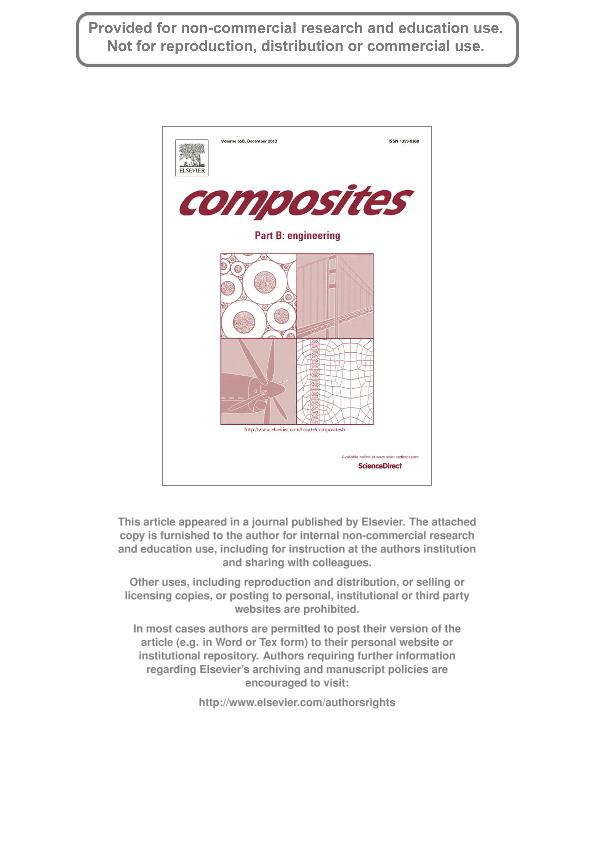Mostrar el registro sencillo del ítem
dc.contributor.author
Escobar, Mariano Martin

dc.contributor.author
Vago, Sebastián
dc.contributor.author
Vazquez, Analia

dc.date.available
2017-04-03T19:38:17Z
dc.date.issued
2013-12
dc.identifier.citation
Escobar, Mariano Martin; Vago, Sebastián; Vazquez, Analia; Self-healing in mortars: rules of selection of healing agents; Elsevier; Composites Part B: Engineering; 55; 12-2013; 203-217
dc.identifier.issn
1359-8368
dc.identifier.uri
http://hdl.handle.net/11336/14725
dc.description.abstract
In the present work key parameters of different epoxy systems (such as viscosity and gel time) were evaluated to be used as healing agents when were included in a cement matrix. Epoxy systems were encapsulated in hollow glass tubes and were introduced in a mortar matrix. Samples were preloaded under three point bending in order to create a crack and release the healing system. After that, they were loaded to measure the residual strength and estimate the healing efficiency. The influence of temperature and the volume of the glass tubes were examined. Regarding the healing efficiency, a higher temperature led to an improvement of autogenous healing of the mortar matrix and a higher degree of crosslinking of the healing agent. For the studied systems, the use of glass tubes with smaller diameter containing the healing system seemed to be better in order to maintain the mechanical properties of the mortar-based composite.
dc.format
application/pdf
dc.language.iso
eng
dc.publisher
Elsevier

dc.rights
info:eu-repo/semantics/openAccess
dc.rights.uri
https://creativecommons.org/licenses/by-nc-nd/2.5/ar/
dc.subject
Self-Healing
dc.subject
Repair
dc.subject
Holow Glass Tubes
dc.subject
Epoxy System
dc.subject.classification
Compuestos

dc.subject.classification
Ingeniería de los Materiales

dc.subject.classification
INGENIERÍAS Y TECNOLOGÍAS

dc.title
Self-healing in mortars: rules of selection of healing agents
dc.type
info:eu-repo/semantics/article
dc.type
info:ar-repo/semantics/artículo
dc.type
info:eu-repo/semantics/publishedVersion
dc.date.updated
2017-04-03T17:28:47Z
dc.journal.volume
55
dc.journal.pagination
203-217
dc.journal.pais
Países Bajos

dc.journal.ciudad
Ámsterdam
dc.description.fil
Fil: Escobar, Mariano Martin. Universidad de Buenos Aires. Facultad de Ingeniería; Argentina. Consejo Nacional de Investigaciones Científicas y Técnicas. Oficina de Coordinación Administrativa Houssay. Instituto de Tecnologías y Ciencias de la Ingeniería; Argentina; Argentina
dc.description.fil
Fil: Vago, Sebastián. Universidad de Buenos Aires. Facultad de Ingeniería; Argentina. Consejo Nacional de Investigaciones Científicas y Técnicas. Oficina de Coordinación Administrativa Houssay. Instituto de Tecnologías y Ciencias de la Ingeniería; Argentina; Argentina
dc.description.fil
Fil: Vazquez, Analia. Universidad de Buenos Aires. Facultad de Ingeniería; Argentina. Consejo Nacional de Investigaciones Científicas y Técnicas. Oficina de Coordinación Administrativa Houssay. Instituto de Tecnologías y Ciencias de la Ingeniería; Argentina; Argentina
dc.journal.title
Composites Part B: Engineering

dc.relation.alternativeid
info:eu-repo/semantics/altIdentifier/url/http://www.sciencedirect.com/science/article/pii/S135983681300334X
dc.relation.alternativeid
info:eu-repo/semantics/altIdentifier/doi/http://dx.doi.org/10.1016/j.compositesb.2013.06.023
Archivos asociados
